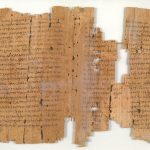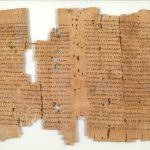| Artefact ID | 986 |
| TM ID | TM 62307 |
| Findspot (DEChriM ID) | - () | Class | Textual |
| Material | Papyrus |
| Writing medium | Codex |
| Text content | Literary |
| Language | Greek |
| Description | Albarrán-Martínez e.a. 2017: 171-188; KV3 Papyrus fragment from a codex containing the Song of Songs (Canticum Canticorum) 5:12-6:10 together with Aristides's Apology 15:6 - 16:1. The papyrus sheet (bifolio, perhaps the outer constituent of a quire) measures 19.5 x 26.3 cm. The sheet presents two folios containing the Song of Solomon (P.Lond.Lit. 209) and the Apology of Aristides (P.Lond.Lit. 223). The second fragment, P.Monts.Roca IV 44), was possibly at one point torn from P.Lond.Lit. 209, and contains parts of the Song of Solomon 5:12-14 and 6:4-5. The fragment measures 3 x 2.8 cm. The columns (one column per page) measure 15 x 10.5 cm and contain 24 and 25 lines of text (verso/recto of P.Lond.Lit. 209/Song of Solomon) and 24 and 27 lines of text (recto/verso of P.Lond.Lit. 223/Apology of Aristides) respectively. The text of P.Lond.Lit. 209 (Song of Solomon) shows several agreements with Codex Sinaiticus and the Codex Alexandrinus. In the P.Lond.Lit.-publications, the hand is described as a medium sized, sloping uncial. Punctuation appears in the form of an enlarged space with the occasional mid-point. The text of the Apology (P.Lond.Lit. 223) contains several nomina sacra. In both texts there are instances of diaereses above word-initial iota (above upsilon as well in the Song of Solomon, in both P.Lond.Lit. 209 and P.Monts.Roca IV 44). P.Lond.Lit. 209 also contains several apostrophes, some with multiple appearances within one word (see κοκ'κ'ινο in l. 33). A sign resembling a spiritus asper can be seen above the omega in l. 44 of P.Lond.Lit. 223. There is also a peculiar sequence worth mentioning in the Song of Solomon: According to the transcription of the ref. ed., between 5:12 and 5:13, there is inserted the latter part of the verse 5:14 (5:14b). |
| Selection criteria | Literary genre (Biblical), Literary genre (Theological), Nomina sacra |
| Date from | 250 |
| Date to | 399 |
| Dating criteria | Palaeography. The editor of the P.Lit.Lond.-publications (Milne 1927) placed P.Lond.Lit. 209 and 223 in the early 4th c. The editor of the Roca 84-fragment (Roca-Puig 1975) places it in the second half of the 3rd c., rather than in the early 4th. |
| Absolute/relative date | Relative date |
| Archaeological context | The provenance is unknown, yet Oxyrhynchus has been suggested: the fragment was acquired by the British Museum from the antiquities dealer Maurice Nahman in September 1922. |
| Accession number | London, British Library Pap 2486 + Montserrat, Abadia Roca inv. 84. The Abadia Roca 84-fragment was previously stored in Barcelona, Fundacion San Lucas Evangelista as inv. no. 84. |
ARTEFACT IDENTIFIERS
Reference edition:
• Spottorno y Díaz-Caro, María Victoria. 2017. "Nueva edición de P.Monts.Roca IV 44 +P.Lond.Lit.209". Estudios papirológicos. Albarrán Martínez, María Jesús, e.a., eds. 171-188.
Editiones principes:
• Milne, H. J. M. 1923. "A New Fragment of the 'Apology' of Aristides". Journal of Theological Studies 25. 73-77.
• Roca-Puig, Ramon. 1975. "Song of Songs V. 12, 14, 13, VI. 4-5; P. Barc. Inv. No. 84". Journal of Theological Studies N.S. 26 (1). 89-91.
Additional bibliography.
• Aland, Kurt. 1995. Repertorium der Griechischen Christlichen Papyri. II. Kirchenväter. Kirchenväter 3.
• Alpigiano, Carlotta. 1986. "L'Apologia di Aristide e la tradizione papiracea". Civiltà classica e cristiana 7. 333-357.
• Alpigiano, Carlotta. 1988. Aristide di Atene, Apologia. Firenze: Centro Internazionale del Libro. 28-31.
• De Zwaan, J. 1925. "A Gap in the Recently Discovered Greek of the Apology of Aristides 16, 1". Harvard Theological Review 18 (1). 109-111.
• Krueger, G. 1924. "Aristides Apologie 15.6-16.1 im Urtext". Theologische Literaturzeitung 2. 47-48.
• Milne, H. J. M. 1927. Catalogue of the Literary Papyri in the British Museum. London London. 176-178 and 186, papyri no. 209 and 223.
• Pouderon, Bernard, Marie-Joseph Pierre, Bernard Outtier, and Marina Guiorgadze. 2003. Aristide. Apologie. Sources chrétiennes 470. 109-110, and 298-303.
• Rahlfs, Alfred and Detlef Fraenkel. 2004 (1914). Verzeichnis der griechischen Handschriften des Alten Testaments. Göttingen. 219 and 249, descr. no. 952.
• Spottorno y Díaz-Caro, María Victoria. 2014. Papyri at Montserrat in the Roca Puig Collection IV: Greek Papyri from Montserrat. Torallas Tovar, S, K. A. Worp, A. Nodar and M. Victoria Spottorno, eds. Scripta Orientalia 1. Barcelona. Papyrus no. 44 (S).
• van Haelst, Joseph. 1976. Catalogue des papyrus littéraires juifs et chrétiens. Paris. Description no. 269 and 624.


 Json data
Json data





